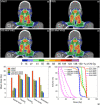Proton Radiotherapy to Reduce Late Complications in Childhood Head and Neck Cancers
- PMID: 34285943
- PMCID: PMC8270100
- DOI: 10.14338/IJPT-20-00069.1
Proton Radiotherapy to Reduce Late Complications in Childhood Head and Neck Cancers
Abstract
In most childhood head and neck cancers, radiotherapy is an essential component of treatment; however, it can be associated with problematic long-term complications. Proton beam therapy is accepted as a preferred radiation modality in pediatric cancers to minimize the late radiation side effects. Given that childhood cancers are a rare and heterogeneous disease, the support for proton therapy comes from risk modeling and a limited number of cohort series. Here, we discuss the role of proton radiotherapy in pediatric head and neck cancers with a focus on reducing radiation toxicities. First, we compare the efficacy and expected toxicities in proton and photon radiotherapy for childhood cancers. Second, we review the benefit of proton radiotherapy in reducing acute and late radiation toxicities, including risks for secondary cancers, craniofacial development, vision, and cognition. Finally, we review the cost effectiveness for proton radiotherapy in pediatric head and neck cancers. This review highlights the benefits of particle radiotherapy for pediatric head and neck cancers to improve the quality of life in cancer survivors, to reduce radiation morbidities, and to maximize efficient health care use.
Keywords: neoplasms, radiation-induced; proton therapy; radiotherapy; radiotherapy, intensity-modulated.
©Copyright 2021 The Author(s).
Conflict of interest statement
Conflicts of Interest: Steven J. Frank, M.D., is an Associate Editor of the International Journal of Particle Therapy. Dr Frank reports grants and personal fees from Hitachi. Outside the submitted work, Dr Frank is a cofounder of C4 Imaging, LLC, for which he reports grants and personal fees, and he reports personal fees from Varian; grants from Eli Lilly, Elekta, and Breakthrough Chronic Care; and personal fees from Augmenix and the National Comprehensive Cancer Center (NCCN). The authors have no additional conflicts of interest to disclose.
Figures


Similar articles
-
Strategies to Overcome Late Complications from Radiotherapy for Childhood Head and Neck Cancers.Oral Maxillofac Surg Clin North Am. 2016 Feb;28(1):115-26. doi: 10.1016/j.coms.2015.07.009. Oral Maxillofac Surg Clin North Am. 2016. PMID: 26614704 Review.
-
Special radiobiological features of second cancer risk after particle radiotherapy.Phys Med. 2017 Oct;42:221-227. doi: 10.1016/j.ejmp.2017.05.002. Epub 2017 Nov 2. Phys Med. 2017. PMID: 29103987
-
New frontiers in proton therapy: applications in cancers.Cancer Commun (Lond). 2019 Oct 22;39(1):61. doi: 10.1186/s40880-019-0407-3. Cancer Commun (Lond). 2019. PMID: 31640788 Free PMC article. Review.
-
Proton Radiation Therapy for Head and Neck Cancers.Cureus. 2024 Oct 3;16(10):e70752. doi: 10.7759/cureus.70752. eCollection 2024 Oct. Cureus. 2024. PMID: 39493189 Free PMC article. Review.
-
The use of proton therapy in the treatment of head and neck cancers.Cancer J. 2014 Nov-Dec;20(6):421-6. doi: 10.1097/PPO.0000000000000077. Cancer J. 2014. PMID: 25415689 Review.
Cited by
-
Development of a practice-based score to predict extended duration of proton beam therapy session in pediatric patients.Clin Transl Oncol. 2025 Jun 19. doi: 10.1007/s12094-025-03972-4. Online ahead of print. Clin Transl Oncol. 2025. PMID: 40537726
-
The Role of Proton Therapy for Prostate Cancer in the Setting of Hip Prosthesis.Cancers (Basel). 2024 Jan 11;16(2):330. doi: 10.3390/cancers16020330. Cancers (Basel). 2024. PMID: 38254818 Free PMC article.
-
Toxicity and Quality of Life After Locoregional Radiotherapy in Patients With Thyroid Cancer.Head Neck. 2025 Jun;47(6):1653-1664. doi: 10.1002/hed.28076. Epub 2025 Jan 22. Head Neck. 2025. PMID: 39840437 Free PMC article.
-
Effective local control of a giant calvarial hemangioma in a child by proton beam therapy: A case report and literature review.Exp Ther Med. 2024 Nov 18;29(1):14. doi: 10.3892/etm.2024.12763. eCollection 2025 Jan. Exp Ther Med. 2024. PMID: 39624589 Free PMC article.
-
Potential Benefits of Combining Proton or Carbon Ion Therapy with DNA Damage Repair Inhibitors.Cells. 2024 Jun 19;13(12):1058. doi: 10.3390/cells13121058. Cells. 2024. PMID: 38920686 Free PMC article. Review.
References
-
- Albright JT, Topham AK, Reilly JS. Pediatric head and neck malignancies: US incidence and trends over 2 decades. Arch Otolaryngol Head Neck Surg. 2002;128:655–9. - PubMed
-
- Robison LL, Mertens AC, Boice JD, Breslow NE, Donaldson SS, Green DM, Li FP, Meadows AT, Mulvihill JJ, Neglia JP, Nesbit ME, Packer RJ, Potter JD, Sklar CA, Smith MA, Stovall M, Strong LC, Yasui Y, Zeltzer LK. Study design and cohort characteristics of the Childhood Cancer Survivor Study: a multi-institutional collaborative project. Med Pediatr Oncol. 2002;38:229–39. - PubMed
-
- Hein PA, Gladstone DJ, Bellerive MR, Hug EB. Importance of protocol target definition on the ability to spare normal tissue: an IMRT and 3D-CRT planning comparison for intraorbital tumors. Int J Radiat Oncol Biol Phys. 2005;62:1540–8. - PubMed
-
- McDonald MW, Esiashvili N, George BA, Katzenstein HM, Olson TA, Rapkin B, Marcus RB., Jr Intensity-modulated radiotherapy with use of cone-down boost for pediatric head-and-neck rhabdomyosarcoma. Int J Radiat Oncol Biol Phys. 2008;72:884–91. - PubMed
-
- Wolden SL, Wexler LH, Kraus DH, Laquaglia MP, Lis E, Meyers PA. Intensity-modulated radiotherapy for head-and-neck rhabdomyosarcoma. Int J Radiat Oncol Biol Phys. 2005;61:1432–8. - PubMed
Grants and funding
LinkOut - more resources
Full Text Sources
